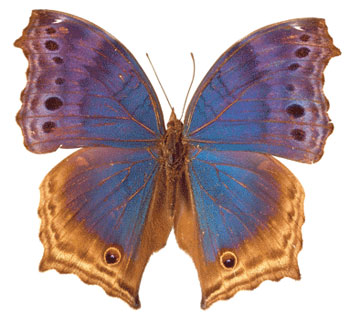| Posted: January 17, 2008 |
Iridescence workshop promotes nature's nanotechnology |
|
(Nanowerk News) The phrase “sex sells” takes on special significance when scientists and students gather. While nature’s showiest subjects step out to promote reproductive success and survival with bright colors, flash and iridescence in feathers, scales, petals and wings, biologists, physicists, behaviorists and materials scientists will delve into what’s behind all the bling at a workshop on “Iridescence” to be held Feb. 6-9 at Arizona State University in Tempe, Ariz.
|
|
“In terms of nanofabrication, nature has surpassed mankind, in both structural intricacy and manufacture, producing nanostructures at body temperature and neutral pH, without caustic reagents or environmental damage and with enviable repeatability for millions of years,” says Nathan Morehouse, doctoral student in ASU’s School of Life Sciences and one of the organizers of this conference.
|
 |
|
The Iridescence workshop will pull participants and panelists from an array of fields and research institutes around the globe, including Japan, Netherlands, Belgium, Brazil, China, Australia, South Korea, U.S., U.K. and Canada.
|
|
Talks and posters will present topics as diverse as how to make photonic crystals, the evolution of iridescent structures in butterflies, cephalopod coloration and sexual signaling in peacocks.
|
|
“This workshop is intended to catalyze cross-disciplinary exchange,” says Melissa Meadows Rader, conference organizer and an ASU doctoral student studying structural coloration in birds.
|
|
“The workshop will present opportunities to identify new avenues for research, and jumpstart new perspectives around iridescent structures, their nano-architecture and function, and understanding about behavior and signaling,” she says.
|
|
Beyond the conference’s core talks and posters, not all will be about Fourier analyses, optics and elytra; human fashion, design, art and education will take their place along with the colorful cache of butterflies, birds, reptiles, mollusks and insects. Dennita Sewell of the Phoenix Art Museum will deliver the event’s closing talk on “Changing appearances: A historic perspective on fashion’s use of iridescent materials” paired with a fashion show by designers Galina Mihaleva and Jacqueline Benard, featuring dancers from the ASU Herberger College of the Arts.
|
|
According to conference participant Ron Rutowski, besides providing a unique opportunity for researchers and students to interact with some of the innovative, international leaders in their fields, the Iridescence workshop will highlight how “beauty, in this case color, is truly in the eye of the beholder.” Rutowski, a professor of life sciences in ASU’s College of Liberal Arts and Sciences, explains: “For example, how butterflies see each other enriches not only our understanding of butterfly coloration, how and why it is being produced, and what it is doing, it also contributes to the broader understanding about the function of evolution and production of coloration in all organisms.”
|
|
“This gathering will be the first, truly international, landmark conference that brings together all the present and future key players in this fantastically interdisciplinary field of science,” notes Peter Vukusic, conference attendee who leads the study of natural photonics with University of Exeter’s School of Physics, U.K. “Many of us have been waiting a decade or more for something just like this to be organized.”
|
|
More information about the conference and invited speakers at: http://sols.asu.edu/rti/frontiers/iridescence.
|

